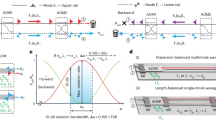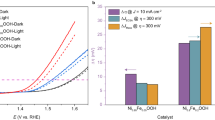Abstract
THE oxygen second negative band system is a result of the transition A2Πu − X2Πg. It is a system of red-degraded double-headed bands, extending from 1900 Å to 6500 Å, and the separation of the heads of each band is 200 cm−1. The bands were first observed by Johnson1 and further identifications have been made by other workers2–6. A list of band-head wavelengths, taken from refs. 1–5, has been published by Wallace7. The frequencies of the band heads are given by 
This is a preview of subscription content, access via your institution
Access options
Subscribe to this journal
Receive 51 print issues and online access
$199.00 per year
only $3.90 per issue
Buy this article
- Purchase on SpringerLink
- Instant access to full article PDF
Prices may be subject to local taxes which are calculated during checkout
Similar content being viewed by others
References
Johnson, R. C., Proc. Roy. Soc., 105, 683 (1924).
Ellsworth, V. M., and Hopfield, J. J., Phys. Rev., 29, 79 (1927).
Mulliken, R. S., and Stevens, D. S., Phys. Rev., 44, 720 (1933).
Lal, L., Phys. Rev., 73, 255 (1948).
Feast, M. W., Proc. Phys. Soc., A, 63, 557 (1950).
Byrne, J., Proc. Phys. Soc., A, 78, 1074 (1961).
Wallace, L., Astrophys. J. Suppl., 7, 165 (1962).
Linton, C., Ph.D., thesis, London (1966).
Author information
Authors and Affiliations
Rights and permissions
About this article
Cite this article
LINTON, C. New Identifications in the Oxygen Second Negative System. Nature 212, 1358 (1966). https://doi.org/10.1038/2121358a0
Received:
Issue date:
DOI: https://doi.org/10.1038/2121358a0



